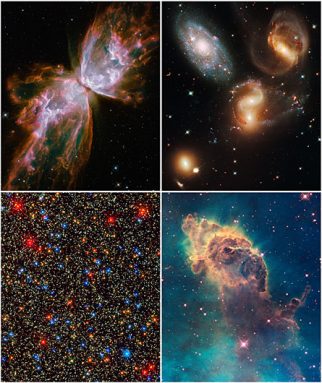Galaxies far, far, far away
Images from the Hubble Space Telescope show galaxies that formed when the universe was a child
How old are the objects you can see in the sky? The brightest star in the night sky, Sirius, is believed to be about 200-300 million years old. The Sun and Moon are much older—about 4.5 billion years old.

New pictures taken by a telescope in space show ancient galaxies that blow those numbers away. Some show galaxies that are about 13 billion years old. The universe itself is only about 13.7 billion years old. So these galaxies formed when the universe was very young.
Garth Illingworth is an astronomer at the University of California, Santa Cruz. He is part of one team that studied the ancient galaxies in the pictures. “We are looking back 13 billion years and seeing galaxies just 600 to 700 million years after the Big Bang, when the Universe was like a 4-year-old,” he says.
The pictures came from the Hubble Space Telescope. It floats through space around the Earth, 353 miles up. For 19 years, this orbiting telescope has been beaming back pictures of deep space to astronomers, who study the images to learn more about the universe and our place in it.
Three teams of scientists studied the pictures. All three found that the most distant reaches of space have fewer bright galaxies than closer regions. This dropoff in the number of galaxies was not surprising, based on what astronomers already knew about the universe. To look deep into space is to look back in time. That’s because light from faraway galaxies takes a long time to reach Earth. When astronomers look at a picture of a distant star or galaxy, they are seeing light that took billions of years to travel to Earth. So when scientists look at these new pictures of distant galaxies, they see the star or galaxy as it looked millions or billions of years ago. This may be at a time when the first galaxies were just forming.
To take these pictures, the telescope used a new tool called the Wide Field Camera 3, or WFC3. Astronauts installed this camera on the telescope in May of this year during a repair mission. Like an ordinary camera, this one takes pictures using visible light. But in addition, it also records snapshots at wavelengths the eye can not see, including ultraviolet light and infrared light
Researchers are excited about the WFC3, which is more sophisticated than earlier cameras on board the Hubble. “This is a golden moment,” says Richard Ellis of Caltech in Pasadena, who also studied the pictures.
All of the galaxies in these pictures showed up in a tiny area of the sky. This slice of sky is so small that 150 pieces the same size would fit into the apparent size of a full moon. Because this slice of the sky is so small and the WFC3 just started taking pictures this summer, the scientists say they’re not sure that they’ll find similar galaxies in every direction.
But they do believe the WFC3 will give scientists some very interesting information about the early universe. “This is a very exciting time,” says Ellis.
POWER WORDS (adapted from the Yahoo! Kids Dictionary)
billion: 1,000,000,000, or 1,000 million
galaxy: A collection of stars, gas and dust that make up the universe. A galaxy contains an average of 100 billion solar masses (or 100 billion times the weight of the sun) and ranges in diameter from 1,500 to 300,000 light-years.
infrared radiation: The range of invisible radiation wavelengths from about 750 nanometers to 1 millimeter, on the border of the microwave region.
ultraviolet radiation: The range of invisible radiation wavelengths from about 4 nanometers, on the border of the x-ray region, to about 380 nanometers, just beyond the violet in the visible spectrum.
telescope: An arrangement of lenses or mirrors or both that gathers visible light, permitting direct observation or photographic recording of distant objects.







